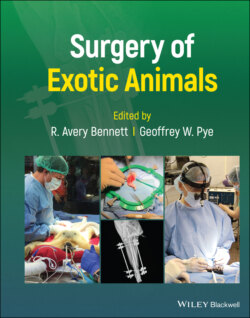Читать книгу Surgery of Exotic Animals - Группа авторов - Страница 93
Crustaceans
ОглавлениеThe crustaceans are a highly successful class of the Phylum Arthropoda although the nomenclature ranking varies among scientists. This group includes lobsters, crabs, crayfish, shrimp, barnacles, and hermit crabs. Numerous other taxa belonging to this taxon include isopods, amphipods, and brine shrimp. Economically, this is one of the most important groups of invertebrates and its members are utilized for food, as display animals, and for research.
Like many of the preceding taxa, much of the surgery applied to crustaceans has been in research and not the clinical setting. Scientists implant electrodes to study physiology (Forgan et al. 2014), surgically remove eyestalks to impact reproductive behavior (Uawisetwathana et al. 2011), sever nerves to study blood pressure changes (Wilkens and Young 2006), ablate neurons to study regeneration of these structures (Harrison et al. 2003, 2004), and use fine forceps to remove the gonads of a pill bug‐like isopod (Suzuki and Yamasaki 1991).
In a more ambitious technical work, Weissburg et al. (2001) transplanted fiddler crab (Uca pugilator) limbs in order to study the well‐known differences between male and female behavior in this species and the neurosensory basis of these behaviors. Fiddler crabs will autotomize limbs when stressed or traumatized. The researchers would apply pressure to a portion (merus) of the feeding appendages in order to induce autotomy. The animals were then maintained through molting stages until a 2.0 mm limb bud appeared. At this time, the animals were placed in 25 ppt artificial seawater with 30 mg/L gentamicin and 4.0 ml/L Fungizone® for three days before surgery. Host crabs were similarly prepared and another surgeon‐induced autotomy of the major claw, and a donor bud was secured to the empty socket with cyanoacrylate adhesive. Over a three‐year period the authors transplanted over 680 claws with 101 developing into functioning feeding claws by the second postsurgical molt. For a thorough review of autotomy among the invertebrates, please refer to Fleming et al. (2007).
